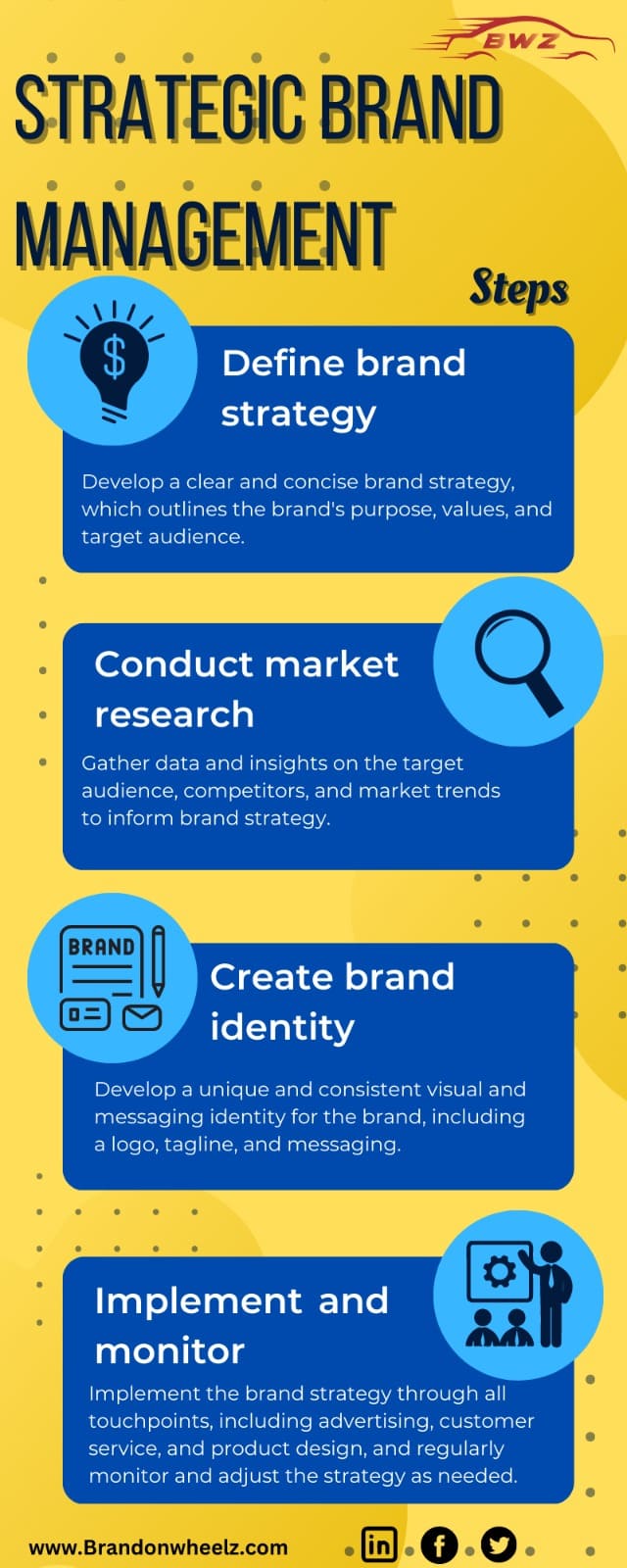In today’s highly competitive business world, having a well-defined brand strategy is crucial to success. Whether you’re a small startup or a large multinational corporation, your brand is your face to the world and the key to attracting customers, building loyalty, and generating growth. In this article, we’ll delve into the four essential steps of strategic brand management, and how they can help you achieve your goals.
Step 1: Define Your Brand Purpose
The first step in building a strong brand is to define your brand purpose. This is a clear and concise statement that captures the essence of your brand and explains what sets you apart from your competitors. Your brand purpose should be aligned with your company’s values and vision, and should reflect the needs and wants of your target audience.
Step 2: Conduct a SWOT Analysis
Once you have defined your brand purpose, it’s time to conduct a SWOT analysis. This involves evaluating your brand’s strengths, weaknesses, opportunities, and threats. The goal of this analysis is to identify areas where you can improve and to identify potential threats that could impact your brand’s success. By conducting a thorough SWOT analysis, you can gain a deeper understanding of your brand’s competitive position and the factors that influence your success.
Step 3: Develop Your Brand Identity
The next step in the strategic brand management process is to develop your brand identity. This includes your brand’s visual elements, such as your logo, color scheme, and typography, as well as your messaging and tone of voice. Your brand identity should reflect your brand purpose and be consistent across all of your marketing materials, from your website to your social media presence.
Step 4: Monitor and Adjust Your Brand Strategy
Finally, it’s important to regularly monitor and adjust your brand strategy as needed. This involves staying up-to-date on industry trends, tracking your brand’s performance, and making changes as needed to ensure you’re staying on track. Regular monitoring and adjustment will help you stay ahead of the curve and stay relevant in today’s fast-paced business world.
In conclusion, implementing a strategic brand management process is a smart investment for businesses looking to build a strong brand and achieve their long-term goals. By following these steps, you can establish a strong brand that sets you apart from your competitors and helps you succeed in today’s competitive business world.
The Benefits of Implementing a Strategic Brand Management Process
Implementing a strategic brand management process can have numerous benefits for your business, including:
Improved Brand Awareness: By defining your brand purpose and creating a consistent brand identity, you can increase your brand awareness and reach a larger audience.
Increased Customer Loyalty: A strong brand can help build customer loyalty by creating an emotional connection with your customers. This can lead to repeat business and positive word-of-mouth referrals.
Better Differentiation: By differentiating your brand from your competitors, you can stand out in a crowded market and make a lasting impression on your target audience.
Increased Credibility: A well-defined brand strategy can increase your credibility and help you establish a professional image in the eyes of your customers.
Improved Decision-Making: The SWOT analysis and regular monitoring of your brand strategy can provide valuable insights into your business and help you make informed decisions about your marketing and branding efforts.
Increased Profitability: By building a strong brand, you can attract more customers and increase your profitability over time.
In conclusion, strategic brand management is essential for businesses of all sizes. By following these four steps, you can build a strong brand that helps you stand out from your competitors and attract the customers you need to grow your business. So why wait? Start building your brand today and watch your business soar!

The Ultimate Guide to Car Branding in India: 4 Proven Steps for Strategic brand management Success.
In today’s competitive market, businesses are always looking for new and innovative ways to reach their target audience. One of the most effective ways to advertise your brand is by incorporating it into your company vehicles. Car Branding in India is a powerful marketing tool that helps businesses to stand out and get noticed. Whether it’s a taxi cab, delivery truck, or executive car, a branded vehicle can help you create a lasting impression on your target audience.
Step 1: Conduct a Comprehensive Market Analysis
The first step in developing a successful car branding strategy is to conduct a comprehensive market analysis. This analysis should include a thorough understanding of your target audience, your competitors, and the overall market trends. Understanding your target audience will help you identify the type of vehicles they are most likely to use, as well as the colors, designs, and messaging that will resonate with them. Understanding your competitors will help you identify their strengths and weaknesses, and determine how you can differentiate yourself from them. Finally, understanding the overall market trends will help you stay ahead of the curve and ensure that your branding efforts are effective and relevant.
Step 2: Develop a Strong Brand Identity
Once you have completed your market analysis, the next step is to develop a strong brand identity. This includes creating a unique logo, selecting a color palette, and developing messaging that aligns with your brand values and goals. Your brand identity should be consistent across all of your marketing materials, including your vehicles. This will help you create a consistent and recognizable brand image that your target audience will remember and associate with your business.
Step 3: Choose the Right Vehicles for Your Brand
The third step in the car branding process is to choose the right vehicles for your brand. This includes selecting vehicles that are appropriate for your business, as well as those that are visually appealing and practical for your target audience. When selecting vehicles, consider factors such as fuel efficiency, reliability, and maintenance costs, as well as your budget. You should also consider the size and design of the vehicle, as well as its overall aesthetic.
Step 4: Implement Your Car Branding Strategy
The final step in the car branding process is to implement your strategy. This involves designing and installing your brand graphics and messaging on your vehicles, as well as maintaining and updating your branding as needed. You should also consider implementing tracking and measurement systems to monitor the effectiveness of your car branding efforts. This will help you make informed decisions about your branding strategy and ensure that you are maximizing your investment.
Conclusion
Car Branding in India is a powerful tool for businesses looking to reach their target audience and increase brand awareness. By following these four steps, you can develop a successful and effective car branding strategy that will help you stand out from your competitors and create a lasting impression on your target audience.




